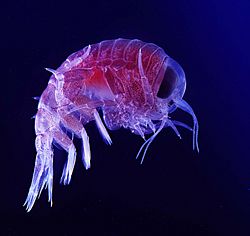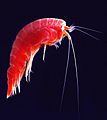Amphipod
| Amphipoda | ||||||||||
|---|---|---|---|---|---|---|---|---|---|---|
 A hyperiid amphipod (Hyperia macrocephala)
| ||||||||||
| Scientific classification | ||||||||||
| ||||||||||
|
Gammaridea |
Amphipod is any of the small, largely marine, shrimp-like crustaceans comprising the arthropod order Amphipoda. Included among the amphipods are the abundant sand-hoppers or beach-fleas, the predaceous ghost shrimp, and the whale ectoparasites Cyamus.
Amphipods are extremely abundant, diverse, and widespread crustaceans, found in nearly all marine and freshwater habitats (Lowry and Springhorpe 2001). They are particularly important in providing benefit to ecosystems in marine food chains, as herbivores, detritivores, micropredators, and scavengers (Lowry and Springhorpe 2001).
Description
Amphipods are poor swimmers, being highly modified as bottom crawlers and scavenging macrophages (Russell-Hunter 1969). They lack a caprapace, have sessile eyes, the pleopods are respiratory in function, and the uropods do not form a tail fin (Russell-Hunter 1969). Amphipods typically are laterally flattened and normally have a division of functions among the varied limbs (Russell-Hunter 1969).
Two characteristic body forms of amphipods are those of the Caprellidea and those of the Gammaridea. The gammarids, which include the beach-fleas, are compact, flattened from side to side, have three pairs of uropods (tail-limbs), the head has two pair of antennae, the eyes are not on stalks, and there are seven thoracic and six abdominal segments that are visible (MVA 1996). The long and skinny Caprellidea—such as the ghost Shrimp Caprella—have very elongated limbs and thoraxes with a reduced abdomen (Russell-Hunter 1969).
Distribution and life
Most amphipods are marine; although a small number of species are limnic or terrestrial. Marine amphipods may be pelagic (living in the water column) or benthic (living on the ocean bottom). Pelagic amphipods are eaten by seabirds, fish, and marine mammals. Terrestrial amphipods such as sand fleas can often be seen among sand and pebbles or on beaches.
Many species of pelagic amphipods are mutualistic or (usually) parasitic, living in association with jellyfish and salps (a barrel-shaped, free-floating tunicate). Phronima is a relatively common genus of pelagic amphipod that kills and cleans out the barrel-shaped body of a salp to live inside and raise its young. Of the relatively few species of free-living, planktonic amphipods, the most abundant of all is Themisto gaudichaudii. Living in the Southern Ocean, this amphipod congregates in dense swarms, where it is a voracious predator of copepods and other small members of the zooplankton.
After copepods, krill, and salps—which are mostly herbivorous—omnivorous Themisto is the most abundant member of the mesozooplankton in the Southern Ocean.
In cold seas, benthic amphipods are enormously diverse and abundant. In the Southern Ocean, amphipods are the most abundant benthic crustaceans. Some are grazers, many are omnivorous, some even act as piranha-like scavengers, quickly cleaning the carcasses of dead animals. Amphipods are one of the few animal groups frequently seen when submarines venture to the deepest parts of the oceans. Other benthic amphipods are the primary food of Gray Whales.
A ship hull fouling species of amphipod common to Atlantic and estuarine waters is Jassa falcata.
ReferencesISBN links support NWE through referral fees
- Holsinger, J. R. “The freshwater amphipod crustaceans (Gammaridae) of North America.” Biota of Freshwater ecosystems Identification Manual, No. 5. Washington: U.S. Environmental Protection Agency, 1972.
- Lowry, J. K., and R. T. Springthorpe. Amphipoda: Families Crustacea.net. 2001. Retrieved September 19, 2007.
- Museum Victoria Australia (MVA). The biology of amphipods Museum Victoria Australia 1996. Retrieved September 19, 2007.
- Russell-Hunter, W. D. A Biology of Higher Invertebrates. London: Macmillan Company, 1969.
Credits
New World Encyclopedia writers and editors rewrote and completed the Wikipedia article in accordance with New World Encyclopedia standards. This article abides by terms of the Creative Commons CC-by-sa 3.0 License (CC-by-sa), which may be used and disseminated with proper attribution. Credit is due under the terms of this license that can reference both the New World Encyclopedia contributors and the selfless volunteer contributors of the Wikimedia Foundation. To cite this article click here for a list of acceptable citing formats.The history of earlier contributions by wikipedians is accessible to researchers here:
The history of this article since it was imported to New World Encyclopedia:
Note: Some restrictions may apply to use of individual images which are separately licensed.


